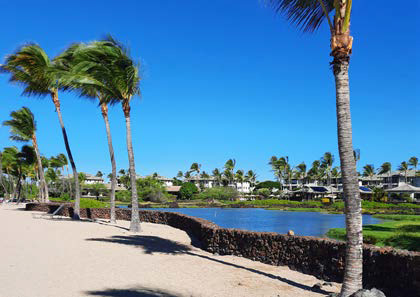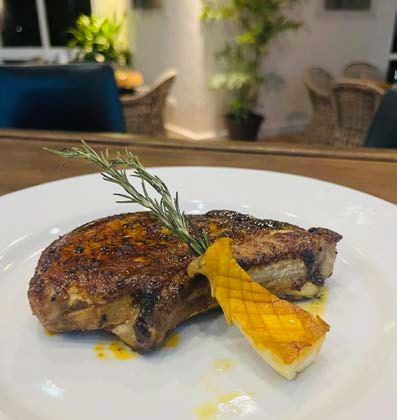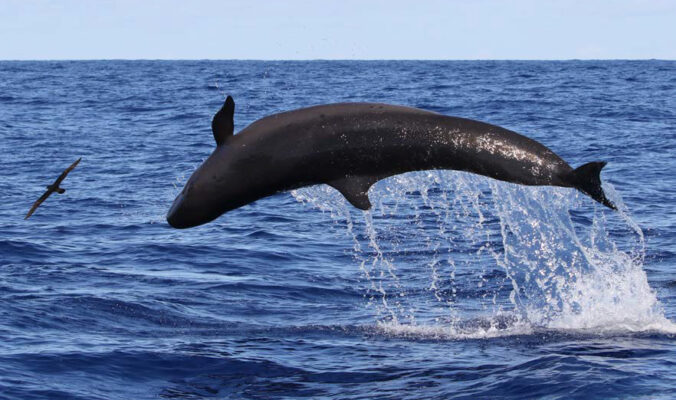 It’s humpback whale season in Hawai`i once again — a big draw for visitors and locals alike. People often line the leeward shores, watching for the giant mammals to spout water, slap their tails and flippers on the ocean’s surface or breach entirely — soaring completely out of the water. It’s truly a spectacle to behold, drawing applause and exhilaration from onlookers.
It’s humpback whale season in Hawai`i once again — a big draw for visitors and locals alike. People often line the leeward shores, watching for the giant mammals to spout water, slap their tails and flippers on the ocean’s surface or breach entirely — soaring completely out of the water. It’s truly a spectacle to behold, drawing applause and exhilaration from onlookers.
And though humpbacks are the main attraction, Hawai`i’s marine mammal population is amazingly broad and it’s of interest to more than spectators. From early September through mid-November, a team of scientists from Cascadia Research Collective, a non-profit research and education organization based in Olympia, Washington, ventured into deeper waters to monitor marine mammals surrounding Hawai`i Island.
This past fall they had 47 encounters with 11 different species of whales and dolphins. Their work included taking identification photos, collecting biopsy or eDNA samples of the mammals and obtaining drone footage.
The scientists’ role is to figure out how populations are doing, what factors may be threatening them and help figure out potential solutions. They also make sure management agencies, such as NOAA Fisheries when it comes to whales and dolphins in Hawaiian waters, obtain and utilize the information they collect.
Cascadia Research’s Dr. Robin Baird is a leading expert on many of Hawai`i’s marine mammals, as a research biologist with more than three decades of experience.
“In our work, we collect small skin and blubber biopsy samples from different species of whales and dolphins — we use these for a lot of different studies, including genetics (to determine sex and figure out who is related to whom, among other things), and stress hormones,” he says. “The stress hormone analyses are being undertaken at the Health and Stranding Lab at the University of Hawai`i. We are also collecting eDNA samples (environmental DNA) from species that are difficult to get close to.”
Dr. Baird adds that false killer whales are one of their key focuses currently, due to the dangers when they become entangled in fishing lines cast by Hawai`i-based offshore longline fisheries. As of 2021, the resident false killer whale population was estimated at 140. According to a researcher at the Pacific Islands Fisheries Science Center, it has been declining at about five percent a year for the last decade.

“In September and October, we were able to collect biopsy samples from false killer whales. The insular population was listed as endangered in 2012, and ‘critical habitat’ was designated in 2018,” Dr. Baird explains. “The endangered insular population did get some protection from offshore longline fishing in 2013, when an area close to the islands became closed year-round to longline fishing. But we know the population is continuing to decline and we know that interactions with local fisheries continue to occur. At the least we need proper monitoring in areas where we think the fishery interactions are most likely occurring.”
Last fall, Cascadia scientists also collected biopsy samples from a Cuvier’s beaked whale, short-finned pilot whales and pantropical spotted dolphins, as well as eDNA samples from dwarf sperm whales, pygmy killer whales and Cuvier’s beaked whales off Kona, exemplifying the diversity of the mammal species in the islands.
“(Pygmy killer whales) are sensitive to acoustic disturbance, so it is possible that the increase in high-intensity fish-finding sonars used by some of the larger charter vessels off Kona to find large fish have resulted in the animals spending less time here,” scientists explain on Cascadia’s Facebook page. “A group of pantropical spotted dolphins included an individual with very unusual pigmentation. There is always a possibility in such cases that this individual is a hybrid, so we collected a small skin/blubber biopsy sample for genetic analyses.”
Scientists are also looking at how climatic events, such as El Niño and La Niña, might be influencing some of mammal species.
“A graduate student working with us, Danny Barrios, has found that Cuvier’s and Blainville’s beaked whales seem to change their movement patterns in response to El Niño cycles, and this may have broader implications for understanding how these and other species may respond to increasing ocean temperatures,” Dr. Baird explains.
Locals and visitors can also have a key role in protecting mammals around Hawai`i Island.
“If you spend time on the water, show respect for the resident (and non-resident) whale and dolphin populations, no matter how you interact with them,” Dr. Baird says. “There are too many people who try to swim with these species — don’t be one of them. If you are approaching them in a boat, do so slowly and carefully.”
He continues, “If you are on the water, you can contribute to our understanding of these species — become a citizen scientist, take photos and contribute those photos to researchers.”
Photos of humpback whales can be emailed to Happywhale.org, and toothed whale or dolphin photos can be contributed to Cascadia Research at [email protected].
Historic Fishpond Protected
 Located on the ocean side of Waikoloa Beach Marriott Resort & Spa, fronted by the beach and Anaeho`omalu Bay, is the historic Kahapapa Fishpond. During winter season, high tides and north swell waves occasionally overtop the beach, resulting in sand potentially being deposited into the ponds. Waikoloa Land Company, in collaboration with the Waikoloa Beach Association, recently contracted a veteran rock wall builder to raise the 300-linear-foot Kahapapa Fishpond wall by two feet to aid in the maintenance and long-term stewardship of the beach and ancient Hawaiian fishpond.
Located on the ocean side of Waikoloa Beach Marriott Resort & Spa, fronted by the beach and Anaeho`omalu Bay, is the historic Kahapapa Fishpond. During winter season, high tides and north swell waves occasionally overtop the beach, resulting in sand potentially being deposited into the ponds. Waikoloa Land Company, in collaboration with the Waikoloa Beach Association, recently contracted a veteran rock wall builder to raise the 300-linear-foot Kahapapa Fishpond wall by two feet to aid in the maintenance and long-term stewardship of the beach and ancient Hawaiian fishpond.

Cultural Walking App
COMING SOON! For visitors seeking a deeper understanding of the vibrant culture and significant preservation sites that shaped this land, a historic walking tour around Waikoloa Beach Resort just got easier. A new app, which can easily be downloaded from your app store, acts as an interactive guide with narratives along the ancient trail. Cultural tour guides share stories and insights about Hawaiian culture, with stops at sacred temples, petroglyphs, royal fishponds and more.
Mauka Steakhouse Brings Paniolo Culture to the Beach
Less than six months after Mauka Bar and Grill opened for breakfast and lunch at Kings’ Clubhouse, a whole new dinner concept launched in the same location last October — Mauka Steakhouse.
“It was always our plan to open as a steakhouse. Our Executive Chef Alika Ambrosio and Sous Chefs Greg and Gavin Ambrosio have a history of working in high-end steakhouses,” says the restaurant’s owner, Brian Flynn.
 The menu brings some of the island’s paniolo (cowboy) upcountry culture down to the resort. Filet, NY Strip and Ribeye steaks, and the Kurobuta Pork Chop are fan favorites. Appetizers range from flaming Oysters Rockefeller to Seared Ahi Tataki.
The menu brings some of the island’s paniolo (cowboy) upcountry culture down to the resort. Filet, NY Strip and Ribeye steaks, and the Kurobuta Pork Chop are fan favorites. Appetizers range from flaming Oysters Rockefeller to Seared Ahi Tataki.
“The Ambrosio family is well known on the island for their passion for culinary arts and ability to cook incredible food,” Flynn says. “This location provides a great opportunity and venue to demonstrate these skilled individuals.”
The freshest local ingredients are sourced from Blue Ocean Mariculture, Kekela Farms, Olokino Farms, Kona Fish and Hilo Products.
The curated wine and cocktail lists created by the restaurant’s Sommelier Ryan Rama includes some unique wines and vintages, as well as craft cocktails. Diners enjoy beautiful mountain and sunset views, and live music nightly.
Reservations can be made by calling (808) 886-7600 or on Open Table. Mauka Steakhouse is open 5 – 9 pm daily.

